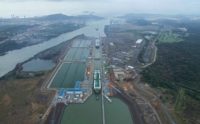Transportation
Panama Canal Officials Detail $1.6B Reservoir Project Needed to Bolster Water Supply

Panama Canal Administrator Ricaurte Vásquez Morales describes the proposal to build the Rio Indio Reservoir to increase the water supply for the canal.
Photo courtesy the Panama Canal Authority
Panama Canal officials say a new reservoir needed to meet the growing water demands of the heavily trafficked waterway would take six years to construct at an estimated cost of $1.6 billion.
In a press conference on July 8, senior members of the Panama Canal Authority (known by its Spanish-language acronym ACP), outlined the next steps forward for the reservoir following a ruling by the country’s supreme court last week that allowed the project to move forward.

Read ENR's recent story on the Panama Canal Authority's ongoing efforts to bolster the water needs of the historic waterway.
Panama Canal Proposes New Reservoir to Secure Water Supply
“Aspects such as climate change and reduced rainfall as well as the increase in population have put the country in an urgent position to make decisions to ensure the future availability of the resource,” said canal administrator Ricaurte Vásquez Morales. “This is a fact that cannot be ignored since it is a primary responsibility of the country and a mandate for the Canal.”
The time to construct the reservoir is estimated at four years, officials said. Prior to that, coordination with the residents of the rural region where it would be sited would take up to two years.
Canal officials currently estimate that the current water reserves needed to accommodate both the canal and Panama’s population will be exceeded by 2030. Recent reviews by both the U.S. Army Corps of Engineers and the ACP found that meeting the canal's growing water needs due to the increasing threat of similar drought conditions would not be possible using conservation measures in the watershed alone.
The additional water provided by the Rio Indio Reservoir would be sufficient to meet the needs of both the canal and the country for 50 years, officials say.
"We want to make it clear that the Canal does not own the land within the Hydrographic Basin; we have the mandate to protect the resources within it, as well as to take actions to improve the quality of life of the people who live there," Vásquez said.
While an estimated 2,000 people reside in area of the proposed reservoir would need to be relocated, the project would require negotiations with approximately 12,000 property owners, Vasquez said.
The ACP estimates it will cost $400 million to purchase the property needed for the reservoir and meet the needs of the impacted communities. The construction of the new reservoir is now estimated to cost $1.2 billion.
A 2003 feasibility report conducted by the ACP called for a concrete-face rockfill dam with a crest at 83 ft. to create a reservoir with gross storage capacity of 1,577 million cu m and cover almost 46 sq kilometers. The new reservoir would be connected to Canal's Gatun Lake by a 8,350-meter-long, 4.5-m-dia tunnel.

The proposed Rio Indio reservoir would be connected to the Gatun Lake by a tunnel.
Map by Scott Hilling/ENR, original inset map by Getty Images
On July 2, the Plenary Session of the Supreme Court of Justice of Panama struck down a 2006 law that included restrictions on its watershed and prohibited construction of reservoirs outside of it. The ruling restored the original limits of the canal’s hydrographic basin which includes the Rio Indio watershed.
Last year, Canal officials asked the Panamanian government to expand its authority to allow the construction of the reservoir. With the ruling by the country’s supreme court, that request has been withdrawn, officials said.
The need for the reservoir became apparent last year when the compound effects of drought and El Niño caused a dramatic drop in the water levels of Gatun Lake – critical to both the operations of the canal and as a water supply for the country. As a result, transits of the canal were dramatically reduced and the ACP launched a series of water conservation efforts.




